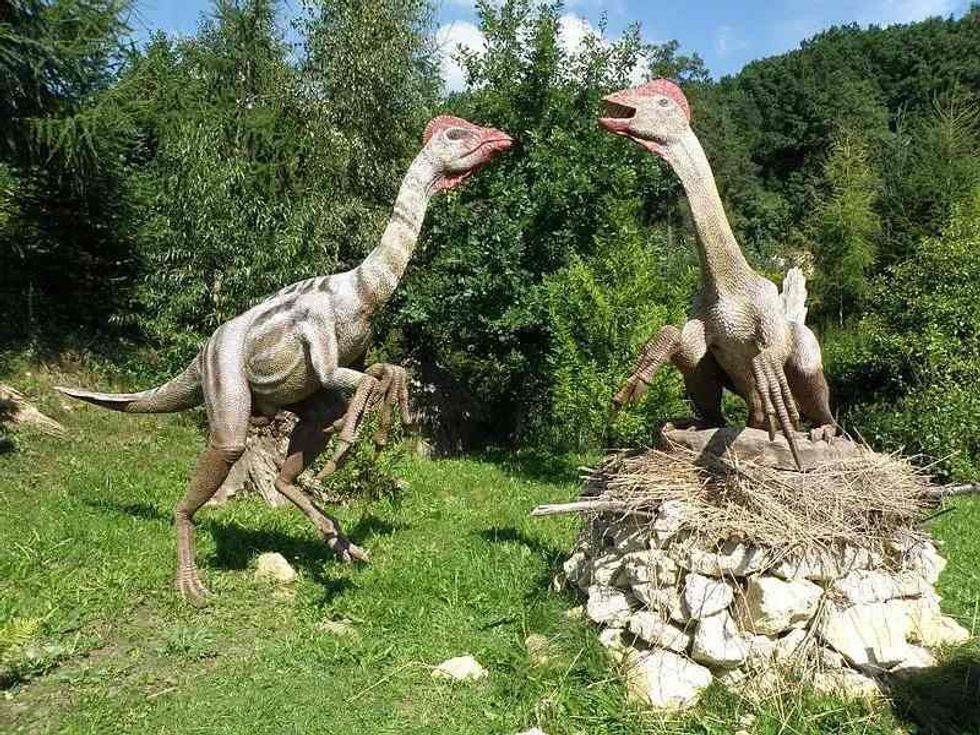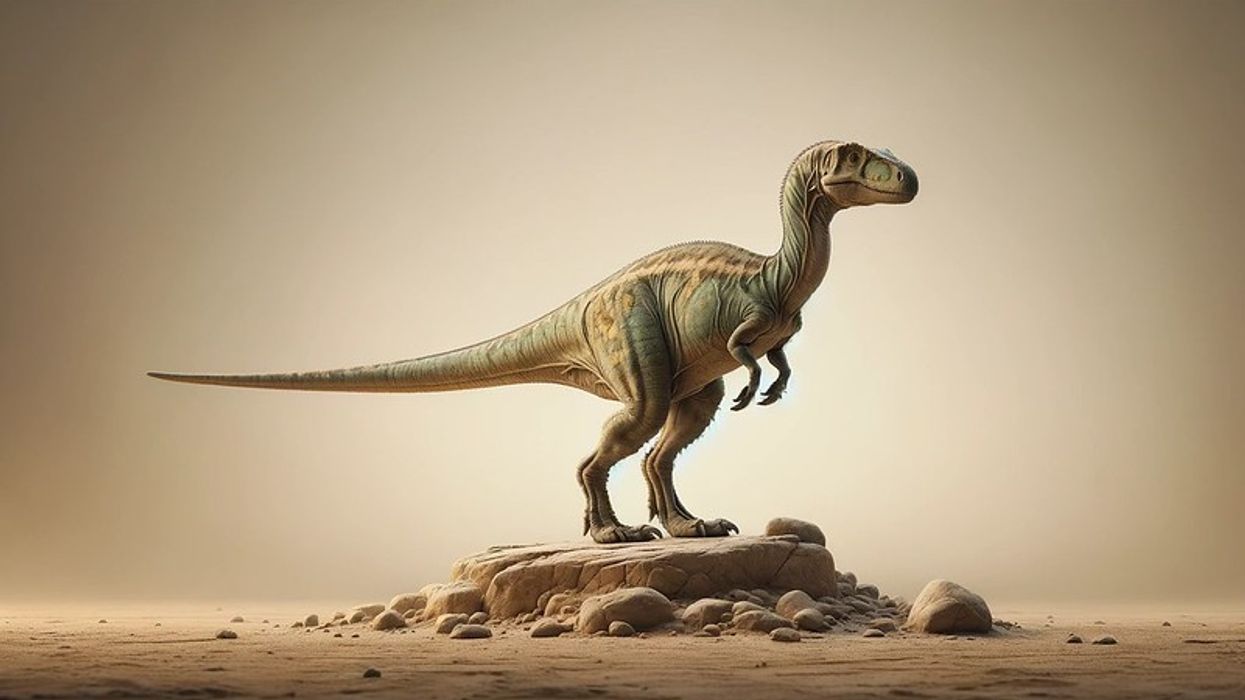The Chirostenotes species of dinosaurs come under the same class as reptiles but take after birds as they displayed bird-like characteristics and functions. These carnivorous dinosaurs lived during the late Cretaceous period around 76.5 million years ago and their fossils were located around parts of North America.
The Chirostenotes dinosaur was found in Alberta of Canada, Coahuila of Mexico, and North Dakota of the United States.
The original fossil specimens were found by George Sternberg and studied further by Lambe. Coming from the Caenagnathidae family and belonging to the genus of oviraptorosaurian dinosaur, paleontologists have discovered about 26 specimens of the Chirostenotes oviraptor species.
The most prominent features of the Chirostenotes were its slender limbs. Its build was lean, having long arms with sharp claws as well as powerful long legs with slender toes.
In 1940, Raymond Sternberg described a jaw with no teeth and concluded that it was a Caegnathus. Alexander Wetmore, in 1960, stated that Caenagnathus was an ornithomimid and definitely not a bird!
In 1969, two dinosaur enthusiasts, Edwin Colbert and Dale Russell mentioned that Chirostenotes and Macrophalangia were one animal but the only similar feature they had was the feet.
By 1981, a complete specimen of the dinosaur Elmisaurus was described in Asia. A further specimen studied in 1988 by Russel and Philip Currie which had been in storage for around 65 years was the final proof that Macrophalangia was indeed a synonym to Chirostenotes.
If you'd like to discover more interesting facts on similar dinosaur species, check out our Xixianykus fun facts for kids or Avimimus interesting facts that you're sure to love!
Chirostenotes Interesting Facts
How do you pronounce 'Chirostenotes'?
The name of this toothless dinosaur that comes from the Caenagnathidae family and Reptilia classification is pronounced as 'kie-ro-sten-oh-teez'. It is was initially classified as Caenagnathus but later it was described to be an Ornithomimid! According to Edwin Colbert and Dale Russell, the hands of the Chirostenotes and feet of the Macrophalangia were same!
What type of dinosaur was a Chirostenotes?
The Chirostenotes was an oviraptorosaur. It lived in the late Cretaceous era. Oviraptorosaurians were dinosaur species that were quite similar to many birds quite significantly in mannerisms, anatomy, and functions. Some scientists believe them to be more closely related to birds than dinosaurs. The type species is also called Chirostenotes pergracilis according to scientist Lawrence Lamb.
In which geological period did the Chirostenotes roam the earth?
The fossils of this omnivore, that was first named by Charles Gilmore but described by Charles Sternberg, were located in Canada and lived about 75-80 million years ago. This put the time of their existence at the Campanian era of the Late Cretaceous.
When did the Chirostenotes become extinct?
The Chirostenotes pergracilis, which were believed to be closely related to modern-day birds, were suspected to have gone extinct about a long time ago as natural occurrences like earthquakes and meteorites must have wiped out their populations.
Where did Chirostenotes live?
These slender dinosaurs that behaved and looked like birds, were found across parts of North America. They lived in rocky plains with rivers and lakes or in valleys with vegetation.
What was a Chirostenotes' habitat?
The Chirostenotes species of dinosaur, initially named by Charles Gilmore, was most likely a terrestrial dinosaur. Known to make their habitats in river plains, lake regions, vegetative valleys, and rocky plains, these dinosaurs with slender limbs and no teeth were quite social and grazed together in a small group or flock.
Who did Chirostenotes live with?
Paleontologists believed that these dinosaurs were quite social and hence, lived in small groups or flocks grazing or preying together.
How long did Chirostenotes live?
Since this animal with no teeth lived many years ago, it is impossible to deduce how long it lived for. Nonetheless, like all other dinosaur species, they would have roamed the earth for about 165 million years.
How did they reproduce?
Very little is known about how these dinosaurs reproduced. Since they belong to the same class as most modern-day reptiles, once the males mated with the females, they would later lay fertilized eggs containing developing dinosaurs.
Chirostenotes Fun Facts
What did a Chirostenotes look like?
 *We've been unable to source an image of Chirostenotes and have used a sketch of a herbivorous dinosaur instead. If you are able to provide us with a royalty-free image of Chirostenotes, we would be happy to credit you. Please contact us at hello@kidadl.com.
*We've been unable to source an image of Chirostenotes and have used a sketch of a herbivorous dinosaur instead. If you are able to provide us with a royalty-free image of Chirostenotes, we would be happy to credit you. Please contact us at hello@kidadl.com.
Raymond Sternberg discovered this animal but it was first named by Charles Whitney Gilmore. The Chirostenotes pergracilis lived about 76.5 million years ago and was not a bird or an ancestor of birds.
Having no teeth, the jaw of this dinosaur species was shaped like a beak. They had long slender arms and equally lean feet that were very powerful for running.
The Chirostenotes claw was sharp enough to sink into soft prey animals. Modern birds and the Chirostenotes may have had a common ancestor. In 1990, scientists were able to draw some conclusions.
They stated that the Macrophalangia is similar to the Chirostenotes in their feet appearance. Nevertheless, the Caenagnathus was concluded to be a separate new genus.
Maastrichtian bones were different from those of the Chirostenotes, as the jaws consisted of teeth. Some paleontologists also believe that the claw was used or gaining a hold on the rocks of cliffs, like a supporting hook.
How many bones did a Chirostenotes have?
It is not known how many bones the Chirostenotes had. Considering their size, they would have definitely had more than 100 bones! They were believed to be related to species like Anzu wyliei and Caenagnathus collinsi since they had similar-looking beaks.
How did they communicate?
This dinosaur species would have engaged in a lot of vocal and visual displays. Those communications likely included hoots and hollers, cracking sounds, dance, and song.
How big was a Chirostenotes?
This animal with long arms, slender toes, and jaws without teeth was about 8.2 ft (2.5 m) in length and about 4.9 ft (1.4 m) in height.
How fast could a Chirostenotes move?
Its bones did not show any clear indication that it could fly. However, from the feet fossils that were discovered, they could have been excellent runners although the exact speed remains unknown till today.
How much did a Chirostenotes weigh?
The Chirostenotes size is about 220 lb (99.7 kg) in weight, the same as giant pandas and warthogs.
What were the male and female names of the species?
These dinosaur species, thought to be Caenagnathus at first, do not have any sex-specific male or female names.
What would you call a baby Chirostenotes?
The babies of this species are called hatchlings or nestlings, just like all other dinosaur babies.
What did they eat?
Chirostenotes, which came from the Reptilia classification, lived in present-day North America. The feeding habits of the animal are again a matter of great doubt.
A majority believe that the Chirostenotes was an omnivore that ate both meat and plants.
Chirostenotes are thought to feed on small reptiles like the babies of crocodiles, alligators and mammals, insects, eggs, and plants. It is likely that the length of its beak made it easy and convenient to reach into the cracks and crevices of rocks and feed on smaller insects or reptiles.
How aggressive were they?
Since they are dinosaurs, a certain degree of aggression would have been displayed with each other in terms of claiming territories, attacking prey, or even defend themselves.
Did you know...
A Chirostenotes fossil from storage since 1923 was discovered and studied by Philip J. Currie and Dale Russell. However, in 1989, Currie assigned it and another fossil foot that had been attributed as a species of Ornithiomimus as O. elegans.
This fossil helped link the other discoveries into a single dinosaur. The name Chirostenotes translates to 'narrow hands' and is taken from the Greek language.
You'd be surprised to know that the Chirostenotes pergracilis dinosaurs lacked teeth! This could prove the fact that they were omnivores who enjoyed eating soft animals like fish, small reptiles, rabbits, squirrels, and so on.
They also fed on various kinds of plant matter. The posture of this Chirostenotes species may be described as similar to the chicken that is used for cockfights.
The discovery of the Chirostenotes created a breakthrough in understanding oviraptorosaurid dinosaurs. Their linked nature between birds and dinosaurs stills astounds scientists and paleontologists.
What sounds did the Chirostenotes make?
The 'narrow-handed' Chirostenotes sounds are still a topic that is currently being studied by scientists and dinosaur researchers with the number of Chirostenotes fossils that have been found.
Were there any omnivorous dinosaurs?
Yes, these toothless oviraptor 'narrow-handed' genus of dinosaurs, which were close relatives to the Elmisaurus, were omnivorous, feeding on plants, small mammals, reptiles, and amphibians too!
Here at Kidadl, we have carefully created lots of interesting family-friendly dinosaur facts for everyone to discover! Learn more about some other creatures from our Kelmayisaurus fun facts for kids, or Liliensternus facts for kids.
You can even occupy yourself at home by coloring in one of our free printable Chirostenotes coloring pages.
Main image by Alina Zienowicz.










